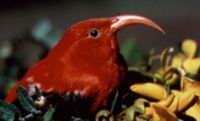Iiwi
Conservation status Near threatened |

ʻIʻiwi
|
|
Scientific classification |
|
|
|
Binomial name |
Vestiaria coccinea
(Forster,
1780) |
The ‘I‘iwi (Vestiaria coccinea) or Scarlet
Hawaiian Honeycreeper is a Hawaiian bird of the family
Drepanididae, and the only member of the genus Vestiaria.
One of the most plentiful species of this family, which
includes many endangered or
extinct species, the ‘I‘iwi is one of the most
recognized animals and symbols of Hawai‘i. It is found on
all the main islands of Hawai‘i, however since the 1800s its
range has become far more restricted due to introduced
species and diseases. Now the ‘I‘iwi can be found at higher
elevations where native forest ecosystems still exist more
or less intact and temperatures are generally too cool for
mosquitoes and the diseases they carry. They are rare or
absent at lower elevations, even where native forests are in
good condition. The species has a very high mortality rate
from avian malaria (Plasmodium
relictum): in a series of challenge experiments, more
than half the birds died from a single infected
mosquito-bite.
It is mainly red in color, with a long curved red bill,
which it uses to drink nectar. The wings and tail are black.
The feathers were highly prized by Hawaiian ali‘i (nobles) for use in decorating ‘ahu‘ula (capes)
and mahiole (helmets).
Although the long bill of the ‘I‘iwi apparently evolved
for feeding on nectar in long curved flowers, they now
depend on nectar from ‘ohi‘a trees (Metrosideros
polymorpha), which have tiny flowers. ‘I‘iwi bill size
has apparently shrunk in the past 100 years due to this
change in food supply.
References
- BirdLife International (2004).
Vestiaria coccinea. 2006 IUCN Red List of
Threatened Species. IUCN 2006. Retrieved on 11 May 2006. Database entry
includes a brief justification of why this species is
near threatened
External links




